Is It Safe to Eat Salmon Skin
Eating salmon skin is generally safe and nutritious when properly cooked. It's rich in omega-3 fatty acids, vitamins B and D, and protein, offering numerous health benefits. However, you should be aware of potential risks. Cooking salmon skin to 145°F eliminates most parasites and bacteria. Wild-caught salmon typically has lower contaminant levels than farmed varieties. To maximize benefits and minimize risks, source your salmon from reputable suppliers and cook it thoroughly. Grilling, baking, or frying can create a crispy texture while preserving nutrients. Remember to reflect on the environmental impact of your salmon consumption. Exploring different cooking methods and sustainable sourcing options can enhance your salmon-eating experience.
This post may contain affiliate links. If you make a purchase through these links, I may earn a commission at no additional cost to you. Additionally, portions of this post may be generated using artificial intelligence (AI) technology. While we strive for accuracy, please be aware that AI-generated content may not always be perfect and should be fact-checked when necessary.
The Spatula Scoops
- Properly cooked salmon skin is generally safe to eat and provides nutritional benefits like omega-3 fatty acids.
- Cooking salmon skin to 145°F eliminates most risks from parasites and foodborne pathogens.
- Wild-caught salmon typically has lower contaminant levels than farmed salmon, making its skin safer to consume.
- Removing the skin can reduce exposure to potential pollutants by up to 50%.
- People with fish allergies or sensitivities should avoid salmon skin due to potential severe reactions.
Nutritional Value of Salmon Skin
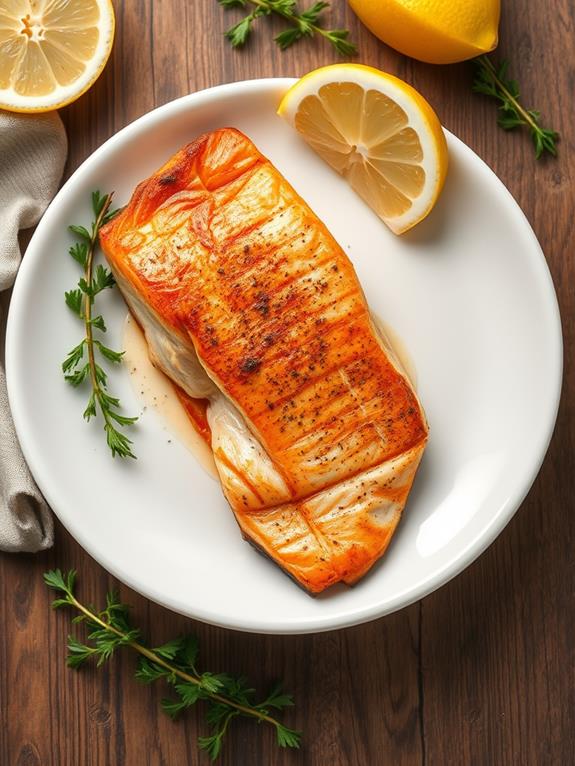
When it comes to the nutritional value of salmon skin, you're in for a treat. This often-overlooked part of the fish is packed with essential nutrients that can greatly boost your health. Salmon skin is rich in omega-3 fatty acids, which your body can't produce on its own. These fatty acids are essential for maintaining heart health and can help lower cholesterol levels. Additionally, incorporating nutrient-rich foods like salmon skin into your diet can enhance your overall wellness. The integrated grips of a John Boos cutting board can make preparing salmon dishes easier and more efficient.
You'll also find important vitamins B and D in salmon skin, along with selenium, a mineral that plays a key role in antioxidant defense. This combination supports your overall well-being and helps protect your cells from damage. The collagen content in salmon skin is particularly beneficial for skin health, promoting elasticity and hydration.
If you're looking to increase your protein intake, salmon skin is an excellent choice. It aids in muscle repair and growth, complementing a balanced diet. The fatty acid profile of salmon skin can also contribute to lowering blood pressure, further supporting heart health. By incorporating salmon skin into your meals, you're not just adding flavor but also reaping numerous health benefits that can positively impact your body from the inside out.
Health Benefits of Eating Salmon
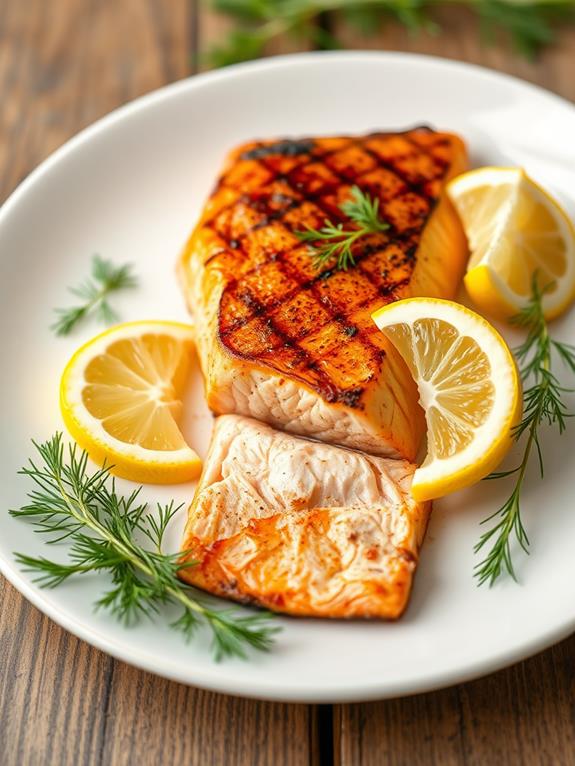
Diving into the health benefits of eating salmon, you'll find a wealth of reasons to add this nutritious fish to your diet. Salmon, particularly its skin, is packed with omega-3 fatty acids that can considerably lower your risk of heart disease. These essential fats help reduce triglyceride levels, promoting cardiovascular health. Additionally, just as choosing the right popular blues for kitchen cabinets can elevate your space, opting for quality salmon can enhance your health. You'll also benefit from important vitamins like D and selenium, which support bone health and antioxidant functions in your body.
Here's why you should consider including salmon in your meals:
- Rich in heart-healthy omega-3 fatty acids
- Contains essential vitamins for bone health and antioxidant support
- Enhances nutrient retention when cooked with skin
- Aligns with FDA guidelines for a healthy diet
When you consume salmon with its skin, you're maximizing nutrient retention. The skin helps preserve beneficial oils and nutrients during cooking. For ideal health benefits, aim to eat salmon 2-3 times a week. While both wild-caught and farmed salmon offer nutritional benefits, wild-caught Pacific salmon tends to have lower levels of contaminants. By choosing salmon from reputable sources, you'll enjoy the numerous health advantages while minimizing potential risks associated with contaminants.
Potential Risks and Safety Concerns
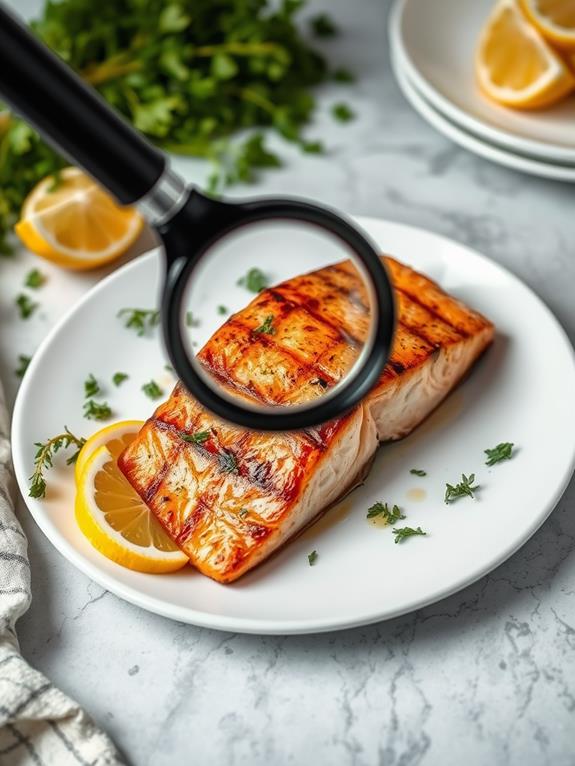
While salmon skin offers health benefits, it's important to be aware of potential risks. You should consider chemical contamination concerns, particularly in salmon from polluted waters, as well as the possibility of parasites and foodborne illnesses if the fish isn't properly handled or cooked. Additionally, improper storage can lead to bacterial growth, making proper handling essential for safety food safety guidelines. Moreover, if you have allergies or sensitivities to fish, consuming salmon skin may trigger adverse reactions, so it's vital to be mindful of your individual health needs.
Chemical Contamination Concerns
Several chemical contamination concerns arise when considering the safety of eating salmon skin. When you're deciding whether to consume salmon skin, it's essential to be aware of potential marine toxins that can accumulate in this fatty tissue. Polychlorinated biphenyls (PCBs) and mercury are two primary contaminants that pose health risks, especially for pregnant women and young children.
- Farmed salmon often contains higher levels of toxins than wild-caught
- Removing the skin can reduce exposure to certain pollutants by up to 50%
- Proper cooking methods may help mitigate some contamination risks
- Sourcing salmon from clean waters is vital for minimizing toxin intake
The source of your salmon plays a notable role in determining its safety. Farmed Atlantic salmon typically has higher concentrations of PCBs compared to wild-caught varieties. If you're concerned about contamination, you might consider removing the skin before eating. Research shows that skinning salmon from polluted waters can greatly reduce pesticide residues. However, it's essential to realize that proper sourcing and cooking methods can also help minimize your exposure to these harmful chemicals. Always stay informed about FDA advisories regarding fish consumption, especially if you're in a vulnerable population group.
Parasites and Foodborne Illness
Beyond chemical contaminants, salmon skin can harbor parasites and bacteria that pose food safety risks. You'll need to be aware of potential parasites like Anisakis and bacteria such as Salmonella or Listeria that can cause foodborne illnesses. Proper cooking is essential to eliminate these threats. When you're handling salmon skin, always guarantee it's cooked to an internal temperature of 145°F to kill any harmful organisms.
| Risk Factor | Raw Salmon Skin | Properly Cooked Salmon Skin |
|---|---|---|
| Parasites | High risk | Low risk |
| Bacteria | High risk | Low risk |
| Nutrients | Preserved | Slightly reduced |
| Taste | Original | Altered |
If you're considering eating raw salmon skin, you should be cautious. Sourcing practices play a vital role in minimizing contaminants and parasites. Wild-caught salmon from reputable suppliers often have lower risks, but it's not guaranteed. If you have a weakened immune system, are pregnant, or elderly, it's best to fully cook salmon skin to reduce health risks. Remember, while cooking salmon skin may slightly alter its nutritional profile, it greatly enhances your safety against foodborne illnesses.
Allergies and Sensitivities
When it comes to allergies and sensitivities, salmon skin can pose significant risks for certain individuals. If you have fish allergies, it's vital to avoid consuming salmon skin, as it can trigger reactions similar to those caused by salmon flesh. Histamine buildup in improperly stored fish may lead to scombroid poisoning, mimicking allergic symptoms.
Here are some key points to take into account:
- Fish allergies can cause severe reactions to salmon skin
- Histamine buildup in poorly stored fish may trigger scombroid poisoning
- Sensitivities to contaminants like PCBs and methylmercury pose risks
- High-fat content in salmon skin may affect those with digestive issues
Vulnerable populations, such as pregnant women and children, should be particularly cautious due to potential sensitivities to polychlorinated biphenyls (PCBs) and methylmercury. If you have pre-existing health conditions affecting digestion, the high-fat content in salmon skin might cause discomfort.
Proper cooking techniques are essential for safety. Boiling or steaming may not effectively eliminate pathogens, so make sure you're using appropriate methods to prepare salmon skin. By being aware of these risks and taking necessary precautions, you can make informed decisions about consuming salmon skin based on your individual health needs and sensitivities.
Wild-Caught vs. Farmed Salmon
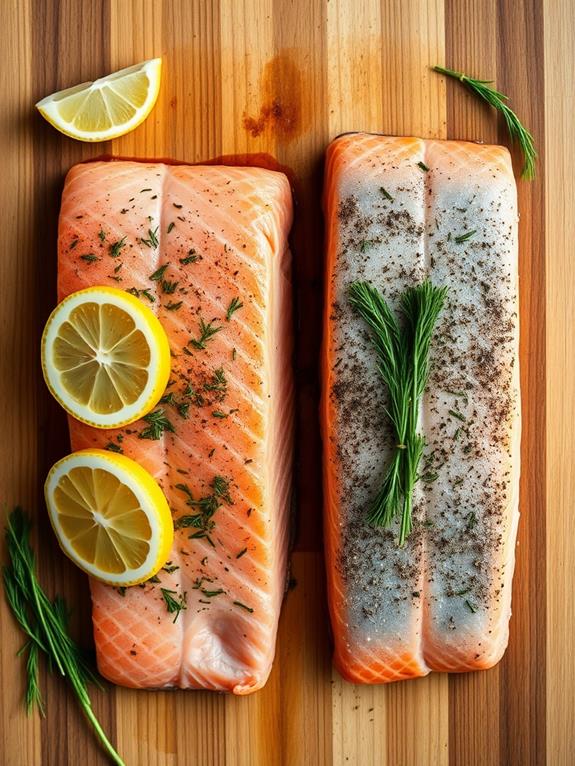
Diving into the debate of wild-caught versus farmed salmon, it's crucial to understand the safety implications for consuming salmon skin. When it comes to wild-caught salmon, particularly from the Pacific, you're generally getting a safer option. These fish tend to have lower levels of contaminants like polychlorinated biphenyls (PCBs) and methylmercury compared to their farmed counterparts. Wild salmon also boast higher omega-3 fatty acid content, making them a healthier choice overall. In addition, much like Costa Rica's commitment to environmental stewardship and sustainable practices in their eco-tourism sector, choosing wild-caught salmon can promote responsible fisheries management, which benefits oceanic biodiversity a strong commitment.
On the other hand, farmed salmon, especially Atlantic varieties, are often raised in more polluted environments. This leads to higher toxic accumulation in the salmon skin. The Environmental Protection Agency (EPA) has highlighted that farmed salmon can contain elevated levels of persistent organic pollutants (POPs), which are linked to various health risks. To guarantee you're making the safest choice, it's recommended to source wild-caught salmon from reputable fisheries. This approach minimizes both environmental and health risks associated with salmon consumption. By being mindful of these factors, you can make informed decisions about whether to eat salmon skin and which type of salmon to choose.
Cooking Methods for Salmon Skin
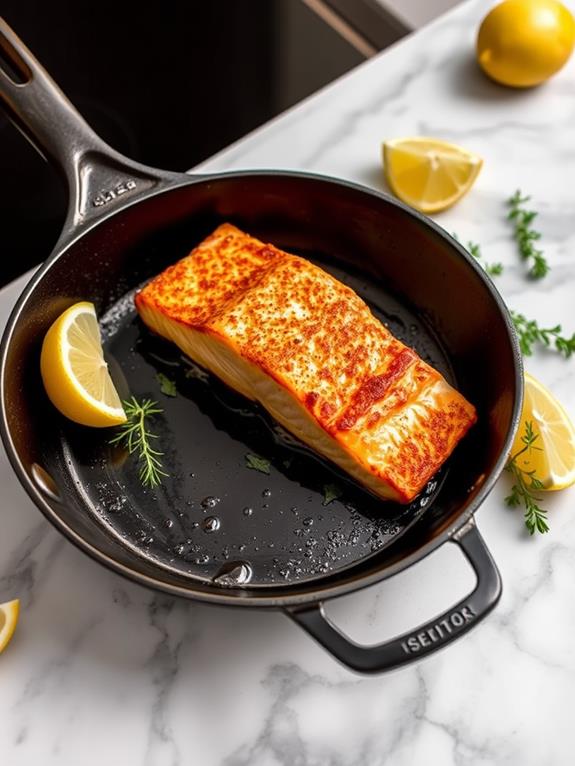
The art of preparing salmon skin lies in choosing the right cooking method. To achieve that perfect crispy texture, you'll want to opt for grilling, baking, or frying rather than boiling or steaming. For a unique flavor experience, consider serving it alongside homemade sauces or using tools like silicone molds for portion control and storage, similar to Souper Cubes' cookie trays. When it comes to preparation, seasoning is key. A simple sprinkle of salt and pepper can elevate the flavor, or you might consider marinating for a more complex taste profile.
Here are some essential tips for cooking salmon skin:
- Cook skin-side down first for even crisping
- Use high smoke point oils like canola or avocado
- Cook at medium heat for 3-5 minutes
- Season before cooking for the best flavor
When frying or grilling, it's vital to use oils with high smoke points to prevent burning while achieving that desired crispiness. As you prepare your salmon, remember to cook it skin-side down initially. This technique guarantees even crisping and prevents overcooking the delicate fish flesh. Aim for medium heat and cook for about 3-5 minutes to strike the perfect balance between crispiness and tenderness. By following these cooking methods, you'll master the art of preparing delicious, crispy salmon skin.
Removing Salmon Skin Properly
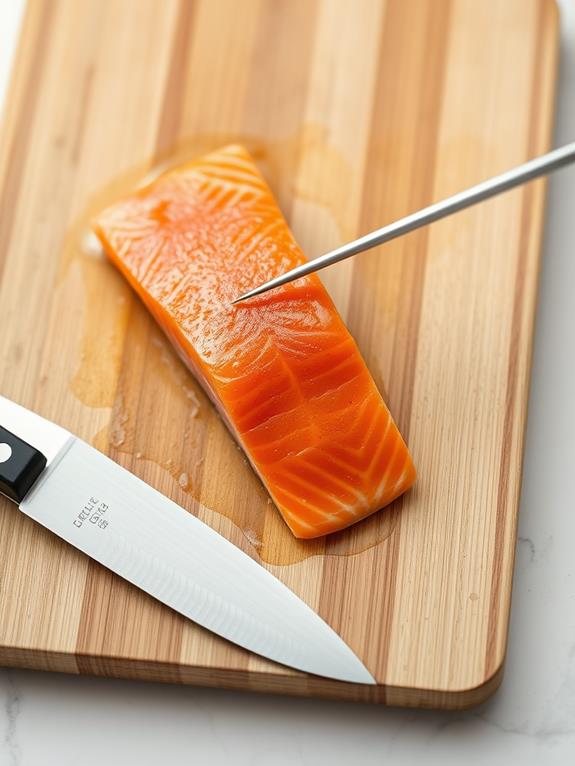
Now that you've mastered cooking salmon skin, you might want to know how to remove it properly. Removing salmon skin correctly guarantees you don't waste any of the delicious flesh. Start by placing your fillet skin-side down on a cutting board. Use a sharp knife, angling it at 45 degrees between the skin and flesh. Begin at the tail end, applying gentle pressure as you cut in a sawing motion towards the head. This technique gives you better control and leverage. Since cast iron skillets, like the Lodge 10.25-Inch Pre-Seasoned Cast Iron Skillet, offer excellent heat retention, they can help you achieve a nice, crispy salmon skin, enhancing the overall flavor of your dish.
If you're struggling to separate the skin, try applying hot water to loosen it. This can make the process easier without damaging the flesh. For cooked salmon, you'll find the skin often detaches more readily due to the heat. Simply peel it away with your fingers or a fork.
When working with raw salmon, be extra careful not to damage the flesh. Maintain firm but gentle pressure on the knife, keeping it at the correct angle. With practice, you'll become adept at removing salmon skin properly, preserving the fillet's integrity and maximizing your culinary enjoyment.
Environmental Impact of Salmon Consumption

When you're choosing salmon, it's important to contemplate the environmental impact of your decision. Wild-caught salmon is often seen as more sustainable, supporting natural fish populations and local economies, while farmed salmon can contribute to pollution and antibiotic resistance concerns. To guarantee you're making the best choice for your health and the planet, pay attention to the quality and safety of kitchen tools used in food preparation, such as a reliable measuring cup set. You can make a more eco-friendly choice by looking for responsibly sourced options with eco-labels or by supporting aquaculture methods that minimize environmental disruption, such as closed-loop systems.
Sustainable Fishing Practices
As consumers become more aware of the impact of their food choices, sustainable fishing practices have risen to the forefront of environmental concerns. When it comes to salmon, you've got several options to guarantee you're supporting responsible harvesting methods. Here are some key points to reflect on:
- Look for eco-labels like the Marine Stewardship Council (MSC) certification
- Choose wild-caught salmon from reputable sources
- Support local fisheries that practice sustainable fishing
- Opt for responsibly farmed salmon when wild-caught isn't available
Sustainable fishing practices focus on maintaining healthy fish populations and minimizing environmental impact. This includes responsible wild-capture techniques and aquaculture methods that reduce pollution and habitat destruction. By choosing sustainably sourced salmon, you're helping to combat overfishing, which is a considerable concern for many salmon species.
When shopping for salmon, pay attention to eco-labels and certifications. These guide you towards products that meet strict environmental standards. If you're reflecting on farmed salmon, look for operations that prioritize responsible aquaculture practices, such as reducing feed waste and chemical usage. Remember, your choices as a consumer can greatly influence the fishing industry and protect marine ecosystems for future generations.
Aquaculture Environmental Concerns
Salmon farming's environmental impact has become a growing concern for eco-conscious consumers. As you consider your seafood choices, it's important to understand how salmon aquaculture affects our ecosystems. Habitat destruction is a major issue, with forests and wetlands often cleared to make way for fish farms. This practice contributes to biodiversity loss in local areas.
Water pollution is another prominent concern. The use of antibiotics and pesticides in farmed salmon production can harm marine life and disrupt aquatic ecosystems. Overcrowding in aquaculture facilities leads to disease spread, prompting increased antibiotic use and potentially causing antibiotic resistance in marine environments.
You should also be aware of the waste produced by salmon farms. Uneaten feed and feces can considerably impact water quality and contribute to eutrophication, harming local fisheries.
To mitigate these environmental impacts, you can choose sustainably sourced wild-caught salmon options. When opting for farmed salmon, look for ecological certifications that guarantee better practices. By being mindful of your choices, you can help reduce the negative effects of salmon consumption on our environment.
Wild vs. Farmed Impacts
Frequently, consumers face a dilemma when choosing between wild-caught and farmed salmon due to their differing environmental impacts. When you're deciding which type to purchase, it's vital to reflect on the effects on marine ecosystems, pollution levels, and sustainable practices.
Wild salmon generally has a lower environmental impact compared to farmed salmon. It doesn't contribute to issues like overfishing or habitat destruction often associated with aquaculture. However, farmed salmon production can lead to pollution of local waterways due to excess feed and waste, affecting nearby ecosystems and fish populations.
Here are some key points to ponder:
- Wild salmon is typically more sustainable than farmed salmon
- Farmed salmon can contribute to pollution and antibiotic resistance
- Eco-label certifications can help guide your choices
- Sustainable practices in fish farming are paramount for reducing environmental impact
When shopping for salmon, look for eco-label certifications like those from the Marine Stewardship Council (MSC) for wild-caught and the Aquaculture Stewardship Council (ASC) for farmed salmon. These labels can help you make more environmentally responsible choices. By being aware of the environmental impacts of your salmon consumption, you can contribute to the preservation of marine ecosystems and support sustainable fishing practices.
Frequently Asked Questions
Why Can't You Eat Salmon Skin?
You can eat salmon skin, but there are reasons why you might choose not to. It can accumulate environmental toxins like PCBs and methylmercury, which pose health risks, especially for pregnant women and children. Farmed salmon is often more contaminated than wild-caught varieties. Removing the skin can reduce exposure to harmful pollutants. If you have fish allergies or certain health conditions, you're advised to avoid salmon skin. However, proper cooking can minimize some risks associated with eating it.
Should I Remove Salmon Skin?
Like peeling back layers of an onion, deciding whether to remove salmon skin depends on your situation. You should remove it if you're pregnant, have fish allergies, or are concerned about contaminants. It's also wise to take it off for certain recipes or if you dislike the texture. However, if you're after the nutritional benefits, particularly omega-3s, you might want to keep it on. If you do, opt for wild-caught Pacific salmon to minimize contamination risks.
Is It Okay to Eat Salmon Skin Scales?
Yes, it's okay to eat salmon skin scales, but you might not find them particularly enjoyable. While scales are edible and contain some nutrients, they're often tough and unpalatable. Most chefs remove them to improve texture. However, small, fine scales can sometimes be left on, as they may crisp up during cooking. If you decide to eat the scales, make certain your salmon comes from clean waters to minimize potential contaminants. Ultimately, it's a matter of personal preference and texture tolerance.
Is the Grey Part of Salmon Healthy?
Did you know that the grey part of salmon contains up to 30% more omega-3 fatty acids than the pink flesh? While this makes it nutritionally valuable, it's not all good news. The grey tissue, or adipose tissue, also accumulates higher levels of contaminants like PCBs and methylmercury. It's a trade-off: you're getting more beneficial nutrients, but also potentially more toxins. If you're concerned, you can trim it off, but occasional consumption in moderation is generally considered safe for most people.





